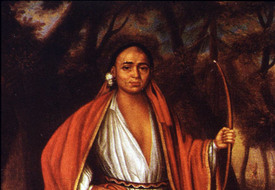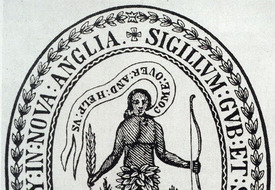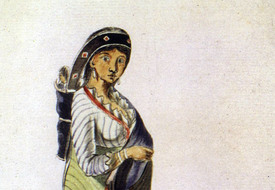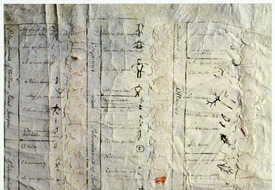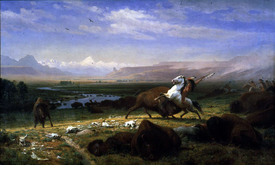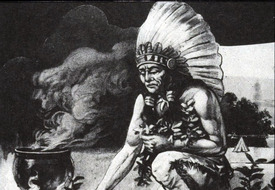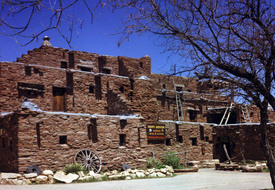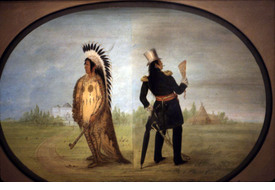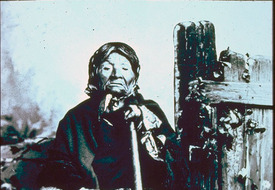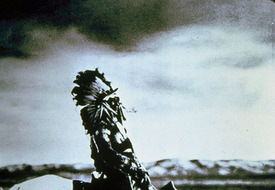Verelst, Ho Nee Yeath Taw No Row, King of Generethgarich (Iroquois John), 1710
Image ID: 12655
Collection: Alan Taylor
Topic(s): Colonies, Arts and Architecture, Indian Americans, Native Americans
Region(s): North America
CA Standard(s): 5.3 - The cooperation and conflict among the American Indians and between the Indian nations and the new settlers, 5.3 - The cooperation and conflict among the American Indians and between the Indian nations and the new settlers
National Standard(s): Colonization and Settlement (1585-1763)
Card Text: Jan Verelst, "Ho Nee Yeath Taw No Row, King of Generethgarich," a pro-English Mohawk and diplomat, 1710. He was one of four Native American envoys sent to London to request Britain's recognition of the Iroquois Confederation as a sovereign nation, and for military aid against the French. Oil on canvas.
Citation: Copyright © Library and Archives Canada, 395 Wellington St, Ottawa, ON K1A 0N4 CANADA. Gift of Queen Elizabeth II, 1977. All rights reserved.
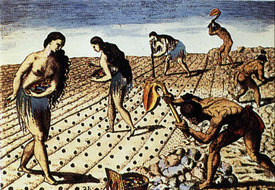
Timucuan Women, FL, 1560s
Image ID: 6839
Collection: Karen Halttunen
Topic(s): Seventeenth Century, Native Americans, Agriculture, Discovery and Conquest, Indian Civilization, Indian-White Relations Before Revolution
Region(s): United States, North America
CA Standard(s): 5.1 - The major pre-Columbian settlements…, 5.2 - Routes of early explorers and early explorations of the Americas, 5.3 - The cooperation and conflict among the American Indians and between the Indian nations and the new settlers
National Standard(s): Three Worlds Meet (Beginnings to 1620) , Colonization and Settlement (1585-1763), Revolution and the New Nation (1754-1820s) , Intensified Hemispheric Interactions 1000-1500 CE, The Emergence of the First Global Age, 1450-1770
Card Text: Jacques LeMoyne, "Timucuan Women," Florida, 1560s, working in agriculture with men. Men plowed and women planted beans and maize. "They be all naked and of goodly stature, mighty, faire and as well shapen…as any people in all the worlde, very gentill, curtious and of good nature… the men be of tawny color, hawke nosed and of a pleasant countenance…the women be well favored and modest…" French explorer Jean Ribault was impressed by these first Native peoples he encountered in Florida. The Timucuans under Chief Saturiwa, who met the French at the mouth of the River of May (later called the St. Johns River) in 1562, were one of a number of Timucua-speaking tribes who inhabited central and northern Florida and southeastern Georgia. Their way of life had remained essentially unchanged for more than 1000 years. Attacks, slavery and disease reduced their numbers. During the Spanish mission period (1595 - 1700) the Timucua population collapsed, from 50,000 people to 1,000, a loss of 98 percent. When the British took over Florida from the Spaniards in 1763, only one Timucua was reported to have survived.
Citation: Library of Congress Rare Book and Special Collections Division, Washington, DC 20540. LC-USZC4-4821. Text: "Timucua," Timucuan Ecological & Historic Preserve Florida, National Park Service, 12713 Fort Caroline Rd, Jacksonville, FL 32225. https://www.nps.gov/timu/learn/historyculture/ timucua.htm. Nov 28, 2017.
Massachusetts Bay Colony Seal, 1629
Image ID: 12420
Collection: Alan Taylor
Topic(s): Colonies, Native Americans
Region(s): North America
CA Standard(s): 5.3 - The cooperation and conflict among the American Indians and between the Indian nations and the new settlers, 7.11 - political and economic change in the sixteenth, seventeenth, and eighteenth centuries (the Age of Exploration, the Enlightenment, and the Age of Reason)
National Standard(s): The Emergence of the First Global Age, 1450-1770
Card Text: Massachusetts Seal: In 1629, King Charles I granted a charter to the Massachusetts Bay Colony, which included the authority to make and use a seal. It featured an Indian holding an arrow pointed down in a gesture of peace, and the unlikely words "Come over and help us," emphasizing the missionary and commercial intentions of the original colonists.
Citation: Image and text: Secretary of the Commonwealth, One Ashburton Pl, Rm 1611, Boston, MA 02108-1512.
A Mohawk Woman Carrying Her Baby on a Board, 18th c
Image ID: 13190
Collection: Alan Taylor
Topic(s): Colonies, 18th Century Portraits, Native Americans
Region(s): North America
CA Standard(s):
National Standard(s): Colonization and Settlement (1585-1763)
Card Text: A Mohawk woman and her baby in a board, 18th c. She is using a tumpline across her forehead to help carry the baby. French watercolor.
Citation: Copyright holder unknown. In Eds. of Time-Life Books, "Realm of the Iroquois" (Time-Life Books, Time Warner Inc., One Time Warner Center, New York, NY 10019-8016) 1993. Gianni Dagli Orti.
Treaty of Greenville, 1795
Image ID: 13097
Collection: Alan Taylor
Topic(s): Revolution, Native Americans
Region(s): United States
CA Standard(s): 5.6 - The course and consequences of the American Revolution, 8.4 - The aspirations and ideals of the people of the new nation, 8.1 - Major events preceding the founding of the nation and the development of American constitutional democracy
National Standard(s): Revolution and the New Nation (1754-1820s)
Card Text: Forced to sign away their rights to the Ohio Valley in the Treaty of Greenville, 1795, Native Americans made their marks beside the English spelling of their names.
Citation: US National Archives and Records Administration, 8601 Adelphi Rd, College Park, MD 20740-6001.
Albert Bierstadt, 'The Last of the Buffalo' 1888
Image ID: 8744
Collection: Karen Halttunen
Topic(s): Nineteenth Century, Indians, Native Americans
Region(s): United States
CA Standard(s): 8.12 - The transformation of the American economy and the changing social and political conditions…in response to the Industrial Revolution
National Standard(s): The Emergence of Modern America (1890-1930)
Card Text: Albert Bierstadt, "The Last of the Buffalo," 1888, oil on canvas, 71-1/8" x 118-3/4"
Citation: In the Collection of the Corcoran Gallery of Art, 500 - 17th St NW, Washington, DC 20006. Accession Number 09.12. Gift of Mary (Mrs. Albert) Bierstadt). All rights reserved. Our thanks to The Corcoran.
Ad: 'Drink Herb-O' 1900
Image ID: 9413
Collection: Karen Halttunen
Topic(s): Nineteenth Century, Advertising, Native Americans
Region(s): United States
CA Standard(s): 11.1 - The significant events in the founding of the nation and its attempts to realize the philosophy of government described in the Declaration of Independence
National Standard(s):
Card Text: "Drink Herb-O," c. 1900, ad; Native American, natural herbal medicines
Citation: Strong National Museum of Play®, One Manhattan Square, Rochester, NY 14607
The Famous Hopi House
Image ID: 9878
Collection: Karen Halttunen
Topic(s): Nineteenth and Twentieth Century, Grand Canyon, Native Americans
Region(s): United States
CA Standard(s): 8.12 - The transformation of the American economy and the changing social and political conditions…in response to the Industrial Revolution, 11.2 - The the relationship among the rise of industrialization, large-scale rural-to-urban migration, and massive immigration from Southern and Eastern Europe
National Standard(s): Expansion and Reform (1801-1861), Colonization and Settlement (1585-1763), The Emergence of the First Global Age, 1450-1770
Card Text: The Famous Hopi House
Citation: Copyright holder unknown. The Panorama Color Slide Co.
'Wi-jún-jon, The Pigeon's Egg Head (The Light), Assineboine Chief' 1837
Image ID: 8797
Collection: Karen Halttunen
Topic(s): Nineteenth Century, Indians, Native Americans
Region(s): United States
CA Standard(s): 8.5 - U.S. foreign policy in the early Republic, 8.8 - The divergent paths of the American people in the West from 1800 to the mid-1800s
National Standard(s): Expansion and Reform (1801-1861)
Card Text: George Catlin, "Wi-jún-jon, The Pigeon's Egg Head (The Light), Assineboine Chief, Going To and Returning From Washington, D.C.," 1837-39, oil on canvas, 29 x 24 in. (73.6 x 60.9 cm).
Citation: Smithsonian American Art Museum, MRC 970, PO Box 37012, Washington, DC 20013-7012. Gift of Mrs. Joseph Harrison, Jr. 1985.66.474. www.si.edu.
Princess Angelina, daughter of Chief Seattle, 1890
Image ID: 5329
Collection: Roland Marchand
Topic(s): Indian Americans, Indian Portraits, Native Americans
Region(s): United States
CA Standard(s): 8.12 - The transformation of the American economy and the changing social and political conditions…in response to the Industrial Revolution
National Standard(s): The Emergence of Modern America (1890-1930)
Card Text: A second image of "the Indian," depicting Indians' real condition at the turn of the century, more accurately reflected by an old woman, Princess Angelina, daughter of Chief Seattle, 1890. She was living in a hovel in the domain her people had owned and her father had ruled.
Citation: Copyright holder unknown. Possibly Delaware North Companies, 40 Fountain Plaza, Buffalo, NY 14202. In Oliver O. Jensen, American Album, 1968, p. 103.
'Oasis in the Bad Lands' 1905
Image ID: 5328
Collection: Roland Marchand
Topic(s): Indian Americans, Indian Portraits, Native Americans
Region(s): United States
CA Standard(s): 8.12 - The transformation of the American economy and the changing social and political conditions…in response to the Industrial Revolution
National Standard(s): The Emergence of Modern America (1890-1930)
Card Text: "Oasis in the Bad Lands" (The North American Indian; v.03). A popular image of "The Indian," Red Hawk, a Lakota Sioux warrior in all his feathers and war paint; but the photo was taken in 1905, 15 years after the last battle his tribe ever fought.
Citation: Edward S. Curtis photo. Seattle Public Library, 1000 Fourth Ave., Seattle, WA 98104-1109. In Oliver O. Jensen, American Album, 1968, p. 102.
8.12.2
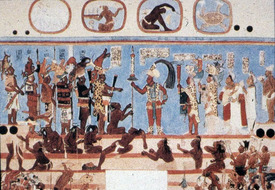
Maya Society Mural, Bonampak, Chiapas, Mexico, c. 800 AD/CE
Image ID: 6688
Collection: Karen Halttunen
Topic(s): Ancient Mexico, Agriculture, Indian Civilization, Indian Portraits, Meso-American, Native Americans
Region(s): Latin America, North America, Mexico
CA Standard(s): 7.7 - The geographic, political, economic, religious, and social structures of the Meso-American and Andean civilizations, 5.1 - The major pre-Columbian settlements…
National Standard(s): The Emergence of the First Global Age, 1450-1770, Intensified Hemispheric Interactions 1000-1500 CE
Card Text: Maya wall mural suggesting an elaborate class system of a complex agricultural society, Bonampak, Chiapas, Mexico, c. 800 AD/CE. A rarely-preserved expression of Maya artistry – painting – comes to life at the archaeological site of Bonampak, in southern Chiapas, Mexico. The small site of three temple rooms houses one of the most famous painted murals in the entire Maya world. Bonampak literally means "painted wall." Vivid colors and masterful designs tell the story of the last ruling family of Bonampak, headed by King Chan Muwan and his wife Lady Rabbit. Calendar inscriptions date the painted scenes between the years 790 and 792 CE. The city was abandoned shortly after, and the murals were never completed. The paintings depict scenes of kingly accession and celebration, brutal warfare, and acts of self-sacrifice. Here members of King Ahau Chan Muwan's court display their power over their defeated rivals in a brutal battle scene.
Painted around 800 AD/CE, these three rooms of paintings reveal in astonishing detail the ancient Maya at the end of their splendor, engaging in court rituals and human sacrifice, wearing elegant costumes and stripping the clothing from fallen captives, acknowledging foreign nobles and receiving abundant tribute. No other surviving work features so many Maya engaged in the life of the court, whether second-tier warriors presenting captives to the king or the king’s mother pushed to the side by her imperious daughter-in-law. Costumes, musical instruments, and the weapons of war are all rendered with great detail, making Bonampak an unparalleled resource for understanding ancient society. The ancient Maya began to build vast cities in northern Guatemala during the first millennium BCE, mastering a harsh tropical environment with shallow soils and annual cycles of deluge and drought. These first cities were the foundation of the greatest civilization of the ancient New World. By 700 AD/CE their towering pyramids and dramatic public monuments dominated dozens of Maya cities across what is now Honduras, Belize, southern Mexico and Guatemala. From at least the 5th century onward, lords at Bonampak skirmished with those from Yaxchilan, 26 kilometers away; but by the 8th century the royal families at the two cities had achieved peace. The king who commissioned the paintings at Bonampak, Chaan Muwan, married a Yaxchilan princess. By 800, when the paintings were nearly completed, the region was suffering from deforestation, exhausted farmland, and overpopulation. Some cities were burned to the ground; others were simply abandoned. By 900 the forest had begun to reclaim the area. Years later Spanish invaders found the region of Bonampak sparsely inhabited, although great Maya populations survived in Yucatan and Guatemala.
Citation: Photo and first text: Copyright © National Museum of the American Indian, Smithsonian Institution, PO Box 37012, SI Building, Rm 153, MRC 010, Washington, DC 20013-7012. https://maya.nmai.si.edu/gallery/bonampak. All rights reserved. Second text: "The Maya Murals of Bonampak: Windows on an Ancient Culture." Copyright © 2017, Yale Peabody Museum of Natural History, 170 Whitney Ave, New Haven, CT 06511. http://peabody.yale.edu/ exhibits/maya-murals-bonampak. All rights reserved. Oct 1, 2017.
